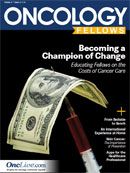Publication
Article
An International Experience at Home
Author(s):
I often find myself in awe of physicians who travel around the world seeking out the 2 most desirable aspects of medicine-patients in desperate need of medical care and patients with genuinely novel pathology
Christopher Dittus, DO, MPH
I often find myself in awe of physicians who travel around the world seeking out the 2 most desirable aspects of medicine—patients in desperate need of medical care and patients with genuinely novel pathology.
The downside of this pursuit is putting yourself in harm’s way, through exposure to endemic infections or dangerous sociopolitical situations. If there were a place where it was possible to safely deliver care to those truly in need and encounter fascinating clinical pathology, then that would be an ideal location to practice medicine. Fortunately, I have found this medical Shangri-La at Boston Medical Center (BMC). As the running joke goes, patients step off the plane at Logan Airport, ask for the nearest hospital, and arrive at BMC. While we may not be the closest hospital to Logan physically, we certainly are the nearest hospital to these patients philosophically. On principle: we don’t turn anyone away.
As a fellow, my first clinic patient was a young man from Honduras who appeared fatigued. Upon examining him, I noted that he had a large spleen. As it turned out, the patient was coinfected with human immunodeficiency virus and leishmaniasis; his lab work also showed pancytopenia.
There was a serious concern that the patient had visceral leishmaniasis. A bone marrow aspirate and biopsy were indicated to help confirm the diagnosis and determine the etiology of his pancytopenia. Before long, we had the pathology results, which revealed leishmania promastigotes. The patient was treated with antiretroviral therapy and liposomal amphotericin B. As of this writing, he is still receiving maintenance amphotericin B treatments on an outpatient basis.
Later in the month, I had the opportunity to make a rare diagnosis, even for a hematologist. A middle-aged Haitian man presented with pancytopenia. His initial lab work revealed that he had a non-autoimmune hemolytic anemia as well as severe iron deficiency. During a return visit, the patient was asked about any source of bleeding and he confirmed that he had been suffering from hematuria for several months. Fluorescein-labeled proaerolysin variant testing confirmed the suspected diagnosis: paroxysmal nocturnal hemoglobinuria (PNH). Because of the large clone of CD59 deficient cells (60%), the patient was initiated on eculizumab therapy. Since beginning therapy, he has shown a vast improvement in his symptoms and cytopenias.
Each of these patients immigrated to the United States in search of a better life. While here, both patients were diagnosed with incurable diseases. Although the first patient may have been diagnosed in his home country, it is unlikely that he would have been able to receive the maintenance amphotericin B that is keeping him alive. The second patient never would have been diagnosed with PNH, let alone received costly infusions of eculizumab on a biweekly basis.
These cases were interesting from a clinical standpoint, but were made even more important by our ability to intervene and improve the length and quality of life for both patients. This is something we would not have been capable of if we had encountered these men in their respective countries.
Later in the year, I rotated on the inpatient service. Here, I had the pleasure of meeting 2 male Haitian patients with adult t-cell leukemia/lymphoma (ATLL) who presented classically with profound hypercalcemia. As my attending at the time said, “ATLL usually comes in threes.” I cannot imagine another place in this country that sees ATLL “in threes”—except, perhaps, Kings County Hospital in Brooklyn.
One of these men was older and had an aggressive lymphomatous subtype. He had comorbid conditions and had failed first-line therapy with zidovudine/interferon. He completed 1 treatment cycle of cyclophosphamide, doxorubicin, vincristine, and prednisone (CHOP) with little response, and passed away after several hospital admissions.
The other gentleman was younger, and his course was particularly complex and heartbreaking because he was a Jehovah’s Witness. Consistent with his religious wishes, he refused blood products. This limited our supportive care and therapeutic options. Initial therapy with zidovudine/interferon was aborted due to cytopenias. Ultimately, he was started on CHOP and was able to tolerate 5 cycles before succumbing to his disease.
Our impact on these patients was not as obvious. They each presented with severe disease that likely would have ended their life immediately if they presented in Haiti, due to severe, refractory hypercalcemia. The first patient lived for several months with his disease but never achieved a durable remission. The second patient did not achieve a durable remission either, but lived for almost a year with his disease. Although the desired outcome of a cure or durable remission was not achieved for either of these patients, it was satisfying to be able to care for them and provide them the best chance of survival. This is the particularly gratifying part of working at Boston Medical Center. We take care of very sick patients, who have limited resources, in a fully state-of-the- art academic facility. Even when we fail, we know we provided our international patients with the best that modern medicine has to offer.
For a truly international medical experience, you don’t need to buy a ticket to South America, Africa, or the Far East. You will not need an active passport or a series of exotic vaccinations. You can simply hop on a plane to Boston and ask for the nearest hospital for those in need. You will be taken to Boston Medical Center, and will not be turned away.










